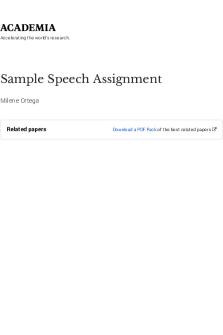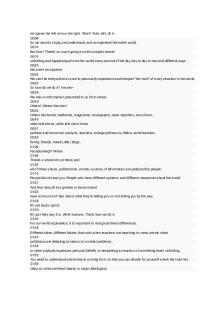Sample Speech Analysis for quiz 2 PDF

| Title | Sample Speech Analysis for quiz 2 |
|---|---|
| Author | Shamim Khaled |
| Course | English composition |
| Institution | North South University |
| Pages | 5 |
| File Size | 147.5 KB |
| File Type | |
| Total Downloads | 88 |
| Total Views | 138 |
Summary
Course work...
Description
Analyze the speech given below. Instructions for analysis: Follow the points in the table for speech analysis. Each section should have a separate paragraph and a subtitle. (Around 150-300 words)
Structure
Content
Effectiveness of the speech Critique
introduction, goals, attention getter, credibility, listener relevance link, thesis statement, preview of points, transitions, body, conclusion, clincher etc. logic, examples, supporting details, language analysis relevance, use of humor, common ground etc. What could/should have been done better/changed
Informative Speech Outline General Purpose: To Inform Specific Purpose: At the end of my speech, my audience will understand the symptoms, causes, and ways to help people with dyslexia. Introduction: (example- write the word “laugh” on the board) (pause) This is how normal people see and spell this word, however to a person that is dyslexic, is might appear to them like this (switch a & u to form luagh), or even like this (write luahg). According to an October 2011 article in The Age newspaper by journalist, Elisabeth Tarica, every 2 in 3 school children have dyslexia. As it is pretty likely that you will encounter a co-worker, friend, or even have a child with dyslexia someday, today I want to take a few minutes to share with you some of the symptoms and causes of dyslexia, as well as some tips on how to help people with the disorder. Transition: The first step to helping someone with dyslexia is being able to recognize the symptoms a person is showing. Main Point 1: The symptoms of dyslexia are usually pretty easy to spot, although it is usually easier to diagnose in school-aged kids. According to both the ADAM Medical Encyclopedia and the Dyslexia Action group, symptoms include: 1. Lower reading level/ slow reading rate. 2. Difficulty interpreting meaning in reading – hard time sequencing problems/ instructions 3. “bad” behavior, acting out caused by frustration. – The number of boys treated for dyslexia is three times that of girls treated for the disorder. Transition: Now that you know what symptoms to look out for, it is often helpful to know what causes dyslexia when trying to help a person live with it. Main Point 2: The causes of dyslexia are mostly internal factors, instead of external factors that cause diseases. 1. Heredity 2. As stated in the April 2009 edition of the Children Now magazine, dyslexia is characterized by Brain processing – doesn’t translate ‘symbols’ 3. No help, feeling helpless, causes a person with dyslexia to be less likely to overcome. Transition: As you can see, the causes of this disorder are usually not something anyone can prevent. This being said, it is well known that even with treatments people are often stuck with dyslexia all their life. Because of this many feel helpless and trapped, however with your support you may make someone learn to live effectively with their disorder.
Main Point 3: Treatments 1. Specialized learning – more attention from teachers/ adults to work around disadvantage 2. According to Jane Gallagher of the Dyslexia Action group in an April 2011 interview, Technology as a learning tool – different fonts appear easier to students 3. Biggest thing you can give is encouragement, remember that it is a disorder, not a disability. Transition: Now you know the effects, causes, and treatments of dyslexia, and can be an informed and helpful person if you ever run into a person with the disorder. Conclusion: Now you know the many symptoms, as well as causes associated with this disorder. With so many children being diagnosed with dyslexia, and numerous adults discovering that they have had the disorder all their lives, it is a good skill to have in both the work world, and even your own household sphere, to be able to recognize the symptoms and provide support. Having my own brother with the disorder, I can tell you that this information has helped me to understand him in better ways than before, and will at least personally be put to use. Keeping this in mind, I hope all of you are leaving here today with the ability to help a dyslexic person in your life.
Answer: ➢ Structure: •
AS dyslexia is an unfamiliar topic to most of the people listening to it, I think the speaker has a pretty good opening though the attention getter where he/she used the example to write the word laugh.
•
Goals: And through his speech I understood his goals that what he wanted the audience to know about dyslexia.
•
Another thing to point out is that he used listener relevant links which are statements that clarify how a particular point is important is important to the listeners by including the co-worker or family or child point.
•
But I find no credibility in his/her speech.
•
The transitions throughout the topics were pretty good as contained a flow of the topic. And the body had enough information with subtitles. The conclusion was short and impactful.
➢ Content: •
Throughout the speech logical information and examples was provided and showed that the speaker had done a pretty good research about the topic by providing the information from magazines and newspaper.
•
The language used by the speaker was formal and appropriate.
➢ Effectiveness of the speech: •
The listener did use the listener relevant link as common grounds as I mentioned above.
➢ Critique:
•
The only complain I have is that as he told the audience to write the word laugh as attention getter was a bit hard to understand from the speech alone. If there were any videos/ images to support the example I would have connected to it more.
•
Another thing is that I couldn’t find any speaker credibility throughout the speech which need to be looked at....
Similar Free PDFs

Sample Outline for Object Speech
- 1 Pages

Sample speech for mooting(bm & eng)
- 19 Pages

Speech Analysis
- 15 Pages

Chapter 2 Sample Quiz-4
- 11 Pages

Sample Formal Speech Outline
- 3 Pages

Persuasive Sample Speech
- 2 Pages

Sample outline&Speech
- 4 Pages

Sample Speech Assignment
- 5 Pages

Sample Persuasive Speech Outline
- 3 Pages

Reliability Quiz - Sample Quiz
- 2 Pages

For video quiz #2
- 18 Pages

Sample assessment 2 FOR BUSSINESS
- 17 Pages
Popular Institutions
- Tinajero National High School - Annex
- Politeknik Caltex Riau
- Yokohama City University
- SGT University
- University of Al-Qadisiyah
- Divine Word College of Vigan
- Techniek College Rotterdam
- Universidade de Santiago
- Universiti Teknologi MARA Cawangan Johor Kampus Pasir Gudang
- Poltekkes Kemenkes Yogyakarta
- Baguio City National High School
- Colegio san marcos
- preparatoria uno
- Centro de Bachillerato Tecnológico Industrial y de Servicios No. 107
- Dalian Maritime University
- Quang Trung Secondary School
- Colegio Tecnológico en Informática
- Corporación Regional de Educación Superior
- Grupo CEDVA
- Dar Al Uloom University
- Centro de Estudios Preuniversitarios de la Universidad Nacional de Ingeniería
- 上智大学
- Aakash International School, Nuna Majara
- San Felipe Neri Catholic School
- Kang Chiao International School - New Taipei City
- Misamis Occidental National High School
- Institución Educativa Escuela Normal Juan Ladrilleros
- Kolehiyo ng Pantukan
- Batanes State College
- Instituto Continental
- Sekolah Menengah Kejuruan Kesehatan Kaltara (Tarakan)
- Colegio de La Inmaculada Concepcion - Cebu



